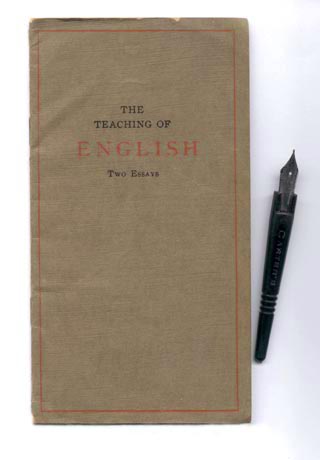|
 Sixteen-page
pamphlet, undated, unpaginated, with no stated publisher or place of
publication. Measuring 3.4" by 6.3", it can be held
open comfortably in one hand. It reprints two journal pieces by
Rose M. Kavana, "Some Recent Phases of English Teaching" from
The Dial (November 1901) and "The Constructive Side of
English Study" from The School Review (April 1902). Sixteen-page
pamphlet, undated, unpaginated, with no stated publisher or place of
publication. Measuring 3.4" by 6.3", it can be held
open comfortably in one hand. It reprints two journal pieces by
Rose M. Kavana, "Some Recent Phases of English Teaching" from
The Dial (November 1901) and "The Constructive Side of
English Study" from The School Review (April 1902).
The pamphlet probably appeared circa 1903,
when Rose Kavana's textbook Composition and Rhetoric Based on Literary
Models was published by Rand McNally. It's likely that Rand McNally
also published this pamphlet. The last page is an advertisement for
the book. But if this pamphlet is a promo, it's still beautifully designed,
with a knowledge of publishing traditions. The rubrication, elegantly
used throughout, partakes of a manuscript history that goes back twenty
centuries.
More interesting, though, is the author
and her sense of composition pedagogy. Rose M. Kavana is identified
as a teacher of English at Joseph Medill High School in Chicago. Composition
and Rhetoric Based on Literary Models, however, is aimed also at
"beginning courses in academies, seminaries, and normal schools."
It definitely is no run-of-the-mill, grammar-thumping comp manual for
high-school sophomores. Some of the method would sound radical in a
school textbook published forty years later. It promotes the "studio
method" of learning to write (p. 3). Examples of art are offered
for students to analyze as models for rhetorical strategy, but also
as "models derived from conversation in our daily life" (p.
7). The textbook is organized around the discourse modes but it does
not treat them in isolation. Narration, description, and exposition
are combined, for instance, to inform assignments of the character sketch
and the biographical essay. This is no slouch of a textbook (Kavana's
co-author, Arthur Beatty, was already on his way to becoming the famous
Wordsworth scholar and editor of De Quincey, Hazlitt, Macaulay, Browning,
Tennyson, and Swinburne).
In 1920, Kavana published another composition textbook, The Elements of English Composition (Boston: The Gordon Press),
single authored this time. In some ways it is even more eccentric and
forward-looking. Oral presentations are assigned before written essays.
Narrative plotlines and combinations of modes are broken down to familiar
life-experiences, illustrated with short passages from literary works,
and then rendered as discourse topics. None of this is simplistic. Under
the category "Incident" for oral compositions, Kavana identifies
thirty or more plotlines ("The Return After an Absense to Find
Changes," "The Blessing that Becomes a Curse," etc.).
For example, the experience of "Sacrifice of Self or What One Holds
Dear" is illustrated from Longfellow, the fall of Troy, and Hugo's
Ninety-Three, and then turned into a topic for oral recitation:
"Have you ever known any one who insisted too little on his own
rights and invited aggression of those not inclined to regard the rights
of others? Tell the class about him" (pp. 80-81).
This is all I can tell the class about Rose M. Kavana,
high-school English teacher extraordinaire. I'd love to hear
from you if you have more information.
RH, May 2004
|
 Sixteen-page
pamphlet, undated, unpaginated, with no stated publisher or place of
publication
Sixteen-page
pamphlet, undated, unpaginated, with no stated publisher or place of
publication